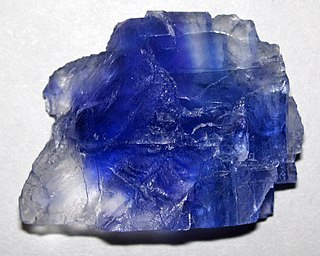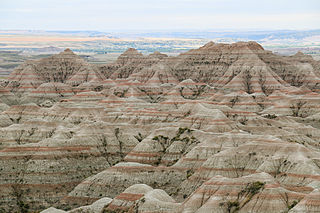
The Williston Basin is a large intracratonic sedimentary basin in eastern Montana, western North Dakota, South Dakota, southern Saskatchewan, and south-western Manitoba that is known for its rich deposits of petroleum and potash. The basin is a geologic structural basin but not a topographic depression; it is transected by the Missouri River. The oval-shaped depression extends approximately 475 miles (764 km) north-south and 300 miles (480 km) east-west.
Bullhead Group is a stratigraphic unit of Lower Cretaceous age in the Western Canada Sedimentary Basin of northeastern British Columbia and western Alberta. It was first defined by F.H. McLearn in 1918 as the Bullhead Mountain Formation, but later was upgraded to group status. It consists of the Cadomin and Gething Formations, although some early workers included the Bluesky Formation and others in the group.

The Belt Supergroup is an assemblage of primarily fine-grained sedimentary rocks and mafic intrusive rocks of late Precambrian (Mesoproterozoic) age. It is more than 15 kilometres (10 mi) thick, covers an area of some 200,000 km2, and is considered to be one of the world's best-exposed and most accessible sequences of Mesoproterozoic rocks. It was named after the Big Belt Mountains in west-central Montana. It is present in western Montana and northern Idaho, with minor occurrences in northeastern Washington and western Wyoming. It extends into Canada where the equivalent rocks, which are called the Purcell Supergroup, are exposed in southeastern British Columbia and southwestern Alberta. The rocks of the Belt Supergroup contain economically significant deposits of lead, zinc, silver, copper, gold, and other metals in a number of areas, and some of the Belt rocks contain fossil stromatolites.
The Joli Fou Formation is a allostratigraphicalunit of middle Albian age in the Western Canadian Sedimentary Basin. It takes the name from the Joli Fou Rapids on the Athabasca River, and was first described in an outcrop along the river, 8 kilometers (5.0 mi) downstream from Joli Fou Rapids, by RTD Wickenden in 1949.

The Elk Point Group is a stratigraphic unit of Early to Middle Devonian age in the Western Canada and Williston sedimentary basins. It underlies a large area that extends from the southern boundary of the Northwest Territories in Canada to North Dakota in the United States. It has been subdivided into numerous formations, number of which host major petroleum and natural gas reservoirs.
The Shaunavon Formation is a stratigraphical unit of Bathonian age in the Western Canadian Sedimentary Basin.
The Vanguard Formation is a stratigraphical unit of Callovian to Oxfordian age in the Western Canadian Sedimentary Basin.
The Gravelbourg Formation is a stratigraphical unit of Bajocian age in the Western Canadian Sedimentary Basin.

The geology of the Isle of Skye in Scotland is highly varied and the island's landscape reflects changes in the underlying nature of the rocks. A wide range of rock types are exposed on the island, sedimentary, metamorphic and igneous, ranging in age from the Archaean through to the Quaternary.

The Gog Group is a stratigraphic unit in the Western Canada Sedimentary Basin. It is present in the western main ranges of the Canadian Rockies in Alberta and British Columbia, and in the Cariboo Mountains and in the central Purcell Mountains in southwestern British Columbia. It was named by C.F. Deiss in 1940 for a type locality near Mount Assiniboine.

The Yahatinda Formation is a geologic formation of Middle Devonian (Givetian) age in the southwestern part of the Western Canada Sedimentary Basin in the mountains of southwestern Alberta. Its type locality lies the on the eastern face of Wapiti Mountain above Ya-Ha-Tinda Ranch at the eastern edge of Banff National Park. The Yahatinda contains a variety of Devonian fossils.
The Blairmore Group, originally named the Blairmore Formation, is a geologic unit of Early Cretaceous age in the Western Canada Sedimentary Basin that is present in southwestern Alberta and southeastern British Columbia. It is subdivided into four formations: Cadomin Formation, Gladstone, Beaver Mines and Ma Butte, all of which are defined by type sections, most of which contain plant fossils. In some areas the Blairmore contains significant reservoirs of natural gas.
The Ma Butte Formation is a stratigraphic unit of Early Cretaceous (Albian) age in the Western Canada Sedimentary Basin. It was named for Ma Butte, a mountain north of Coleman, Alberta, by J.R. McLean in 1980. It is present in the foothills of southwestern Alberta and it contains plant fossils.

The geology of South Dakota began to form more than 2.5 billion years ago in the Archean eon of the Precambrian. Igneous crystalline basement rock continued to emplace through the Proterozoic, interspersed with sediments and volcanic materials. Large limestone and shale deposits formed during the Paleozoic, during prevalent shallow marine conditions, followed by red beds during terrestrial conditions in the Triassic. The Western Interior Seaway flooded the region, creating vast shale, chalk and coal beds in the Cretaceous as the Laramide orogeny began to form the Rocky Mountains. The Black Hills were uplifted in the early Cenozoic, followed by long-running periods of erosion, sediment deposition and volcanic ash fall, forming the Badlands and storing marine and mammal fossils. Much of the state's landscape was reworked during several phases of glaciation in the Pleistocene. South Dakota has extensive mineral resources in the Black Hills and some oil and gas extraction in the Williston Basin. The Homestake Mine, active until 2002, was a major gold mine that reached up to 8000 feet underground and is now used for dark matter and neutrino research.

The geology of North Dakota includes thick sequences oil and coal bearing sedimentary rocks formed in shallow seas in the Paleozoic and Mesozoic, as well as terrestrial deposits from the Cenozoic on top of ancient Precambrian crystalline basement rocks. The state has extensive oil and gas, sand and gravel, coal, groundwater and other natural resources.
The geology of Montana includes thick sequences of Paleozoic, Mesozoic and Cenozoic sedimentary rocks overlying ancient Archean and Proterozoic crystalline basement rock. Eastern Montana has considerable oil and gas resources, while the uplifted Rocky Mountains in the west, which resulted from the Laramide orogeny and other tectonic events have locations with metal ore.

The Pika Formation is a stratigraphic unit of Middle Cambrian age that is present on the western edge of the Western Canada Sedimentary Basin in the Canadian Rockies of Alberta and British Columbia. It was named for Pika Peak near Lake Louise in Banff National Park by C.F. Deiss in 1939. It is fossiliferous and preserves several genera of trilobites. Outcrops of the Pika Formation can be seen in Banff and Jasper National Parks.
The Earlie Formation is a stratigraphic unit of Middle Cambrian age in the Western Canada Sedimentary Basin that is present beneath the plains of Alberta and eastern Saskatchewan. It was named for Earlie Lake in the County of Vermilion River, Alberta, by D.C. Pugh in 1971, who described the type section based on data from an oil well drilled in that area.
The Hollebeke Formation is a stratigraphic unit of Late Devonian (Frasnian) age. It is present on the western edge of the Western Canada Sedimentary Basin in the southern Rocky Mountains of Alberta and British Columbia. It consists of carbonate rocks, and was named for Mount Hollebeke in the Flathead Range near North Kootenay Pass by R.A. Price in 1965.
The Naiset Formation is a stratigraphic unit of Middle Cambrian age. It is present on the western edge of the Western Canada Sedimentary Basin in the southern Rocky Mountains of British Columbia. It consists primarily of siliciclastic rocks, and was named for Naiset Point near Mount Assiniboine by C.E. Deiss in 1940.












